Relaxing With a Rifle in the Land of Beaches and Backstraps.
When it comes to getting a real-world head count on the number of axis deer that inhabit the Hawaiian Islands, the answer you get depends entirely on who you ask. But, between the locals, the Hawaii Department of Land and Natural Resources, everyone who’s ever hunted there, and Wikipedia, there’s a loosely unagreed upon number that lands somewhere north of 100,000 animals.
The island of Molokai measures 10 miles across at its widest point, by roughly 38 miles long, totaling 261 square miles of land mass … or just over 167,000 acres. With more than 70,000 of Hawaii’s axis deer inhabiting Molokai, the island has a deer density of 2.4 per acre. And, given the obvious fact that there aren’t many deer wandering through downtown Kaunakakai — or any of the island’s other communities — that density is much, much higher in the bush.
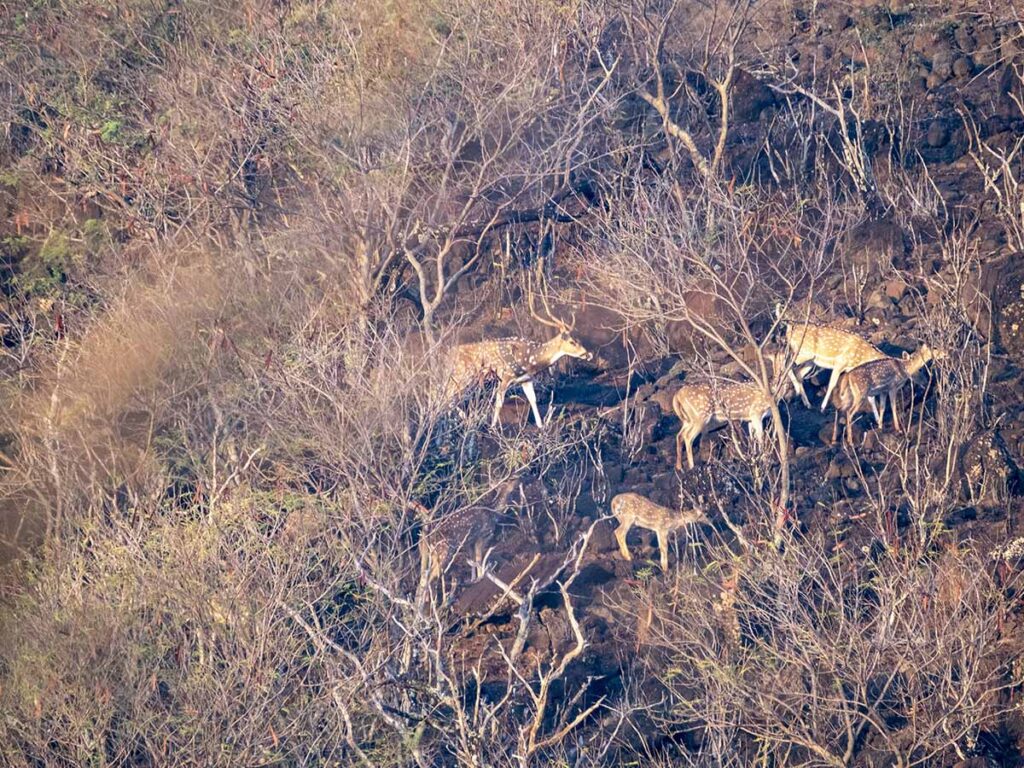
In short, that’s a staggering number of deer. Problematic, even.
But here’s how I like to think of it: Let’s assume that a third of those deer are fawns, and I don’t shoot fawns. There’s just not enough meat on ’em to make burning the tag worthwhile. That leaves roughly 47,000 bucks and does with a target on their back … er, chest. And if each of those animals has 18 inches of backstrap per side (that’s a very conservative number), it can be said that the island of Molokai is growing, at this exact moment, a minimum of 141,000 feet of the best-tasting wild backstrap you can find on this planet.
It’s time to start packing your rifle … and your board shorts.
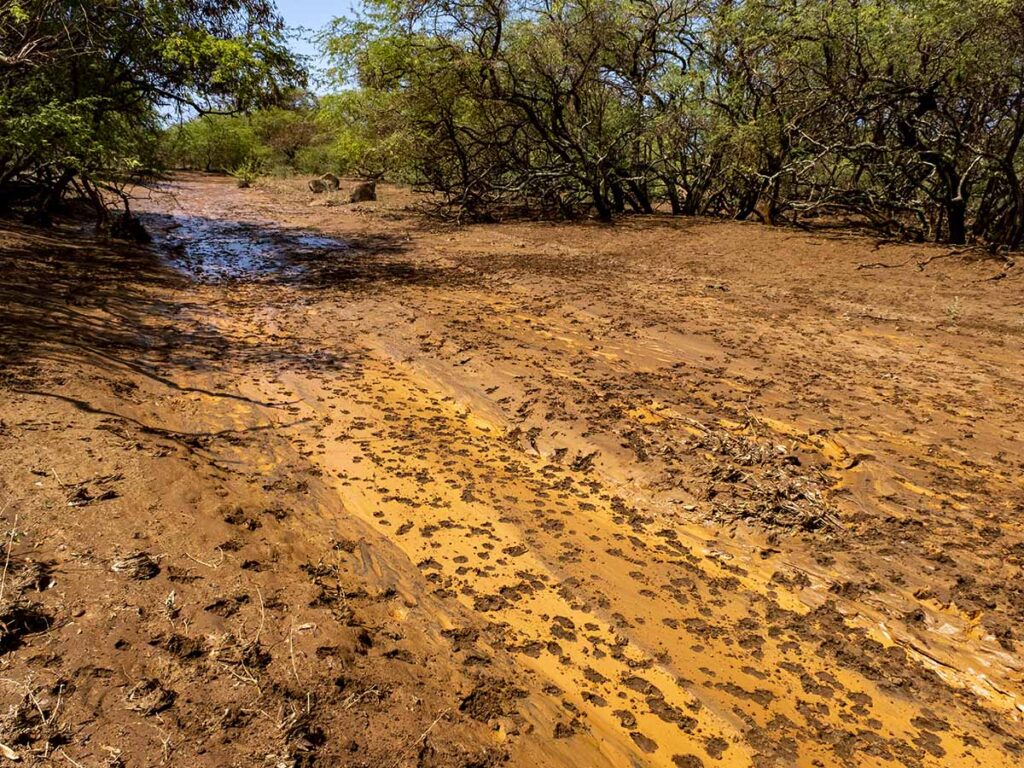
How it Started
Often called “chital” on the global stage, axis deer originate primarily from India, the island of Sri Lanka to the south and neighboring Nepal to the north. The climate in that part of the world resembles that of the Hawaiian Islands.
In 1867, eight axis deer were presented to Hawaii’s King Kamehameha V as a gift from Hong Kong-based traders, which was then under British rule. And for people who hail from a land with absolutely no native mammals — with the exception of a single species of bat — the axis deer were immediately revered by the Hawaiian king.
Exactly how the original eight deer (three bucks, four does and a male fawn) came to disperse is as much a mystery as the current axis deer population on the entire archipelago. Some historians insist that the deer were originally fenced so the king could watch and protect his precious gifts from the Far East, while local Hawaiians I spoke to on Molokai hold fast to the notion that the deer were immediately allowed to wander the island at will. In hindsight, I suppose it doesn’t really matter much anymore.
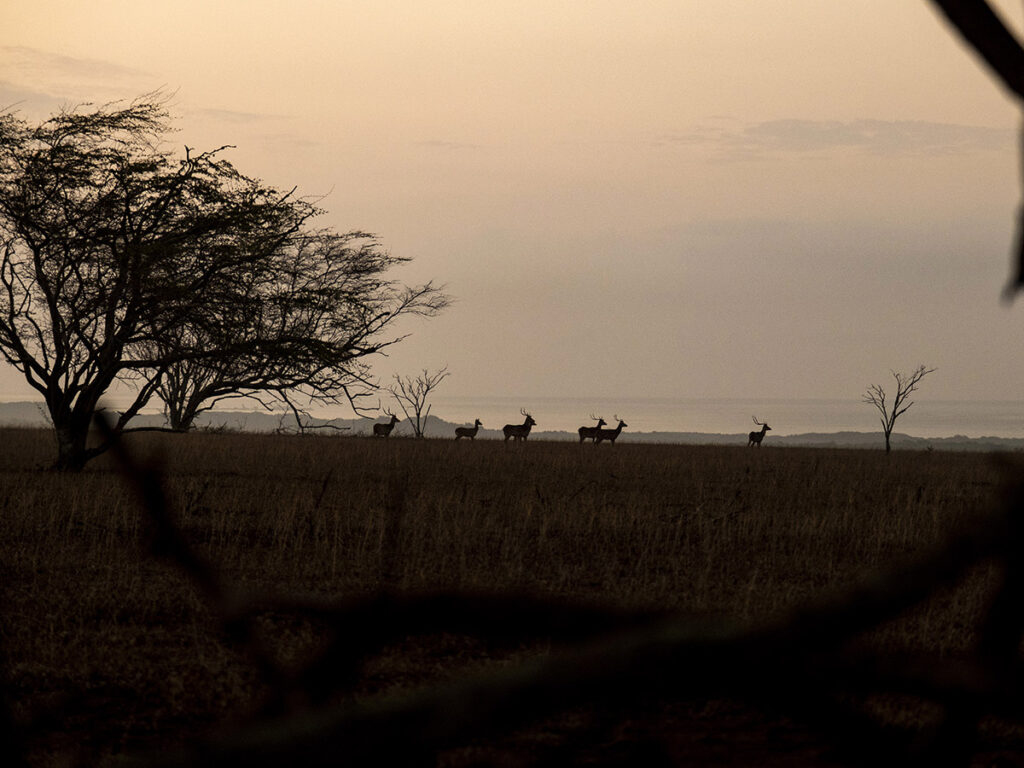
Remember, Molokai is a small island, with no natural predators and a flora base that never evolved thorns to deter the craving appetites of a wild cervid herd. Plus, with no discernible seasonality disruptions — meaning there’s no winter around which the breeding season must revolve to avoid a widespread fawn kill during the cold months — they can reproduce year-round. So, those eight deer did exactly what deer of any species would do: They hooked up and dropped fawns. Lots of fawns.
As the population flourished on Molokai, deer were eventually moved to Oahu and Lanai, and after nearly a century of inhabiting the Hawaiian Islands, axis deer were introduced on Molokai in 1959. And early on, their inhabitance was celebrated in widespread fashion. The axis quickly became a lifeline for early sailors who used Hawaii as a port to trade as they traveled the Pacific Ocean … and restock their fresh meat supply with ample amounts of venison.
For the Hawaiians, the axis deer immediately became a vital source of protein upon their introduction, which holds true today. You’d be hard-pressed to find a local who would pass on fresh axis venison for their freezer. And even though the species’ existence on Molokai is “young” by historical standards, it’s no stretch at all to say that the axis deer have become an integral part of the Hawaiian culture.
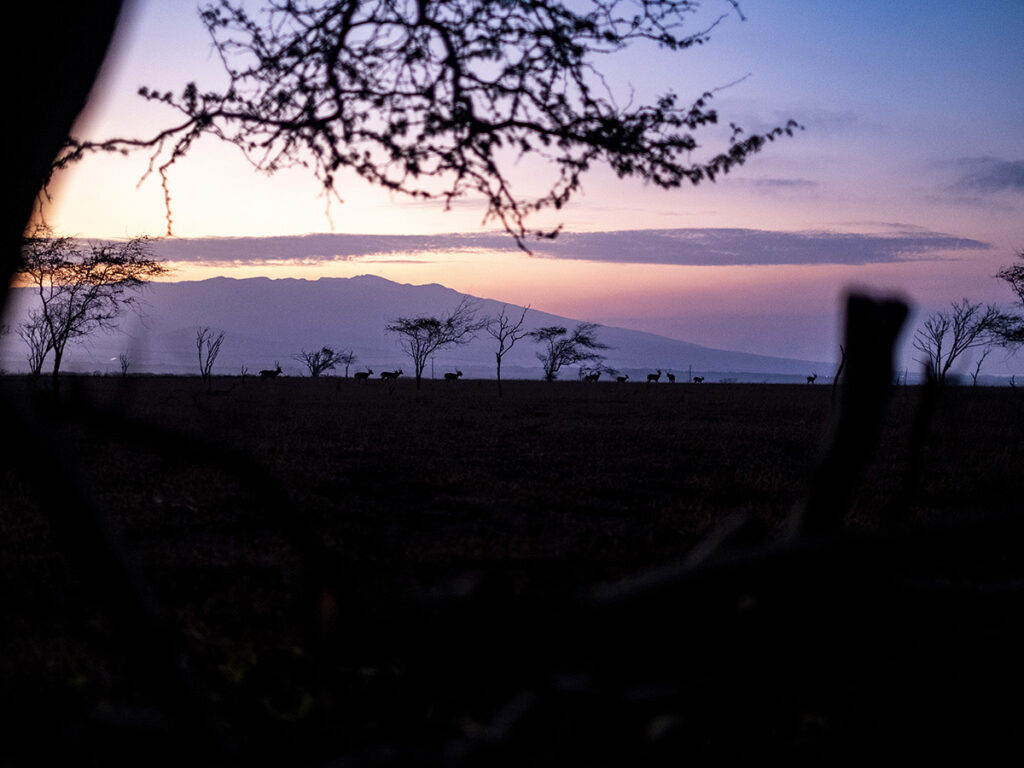
How it’s Going
The first herd of axis deer materialized from the misty horizon a few minutes before legal shooting light. It was the fourth day of the hunt, so I had some expectations about what was about to unfold, but I was unprepared for what was about to come through that fog.
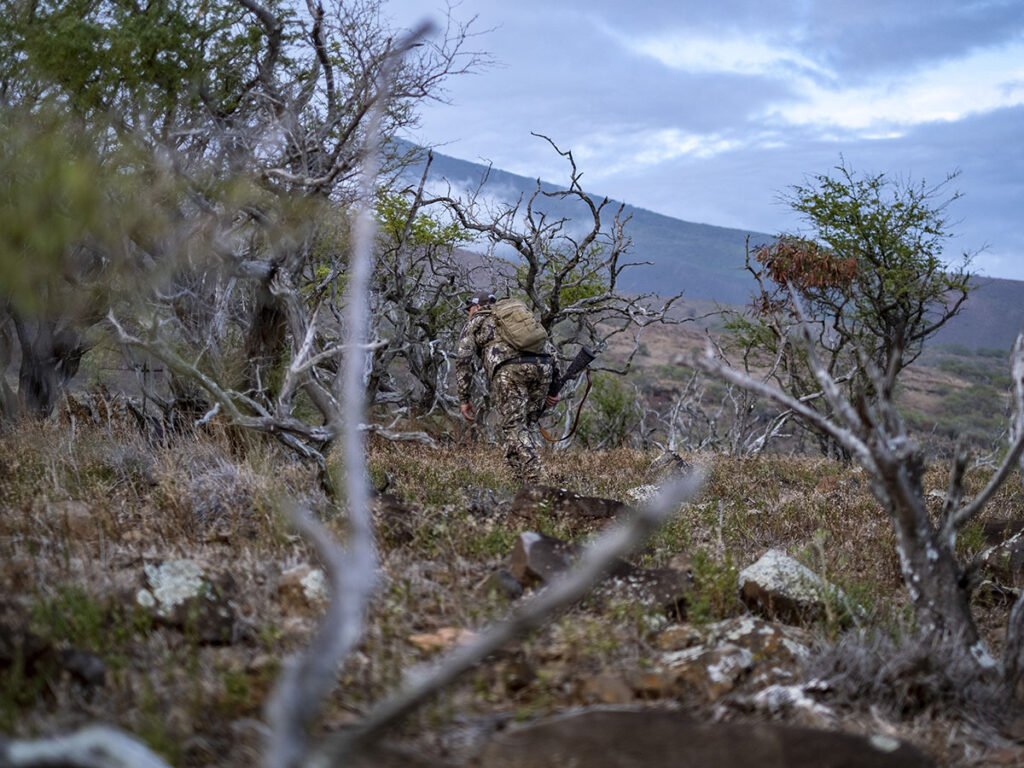
Had I awoken in that exact location at that exact moment, it wouldn’t have taken much to convince me I was hunting the savannahs of Namibia … except for the stunning panorama of the Pacific as the backdrop. And let me tell ya: it’s a unique experience to be in full camo, with a rifle in-hand, and be able to see the ocean. The way those early rays of light interacted with the horizon was nothing shy of amazing.
Ku and I were hunkered beneath an ancient mesquite tree, its limbs reaching toward the sky before bending and returning to the ground, almost as if they’d given up trying to grow upward under the strain of their own weight. With a patchwork of dead sticks woven around the trunk’s perimeter in a makeshift fence to provide additional concealment, I couldn’t help but think about the previous hunters — maybe hundreds of them — who hunkered in that exact location and committed to memory the sights I was about to experience.
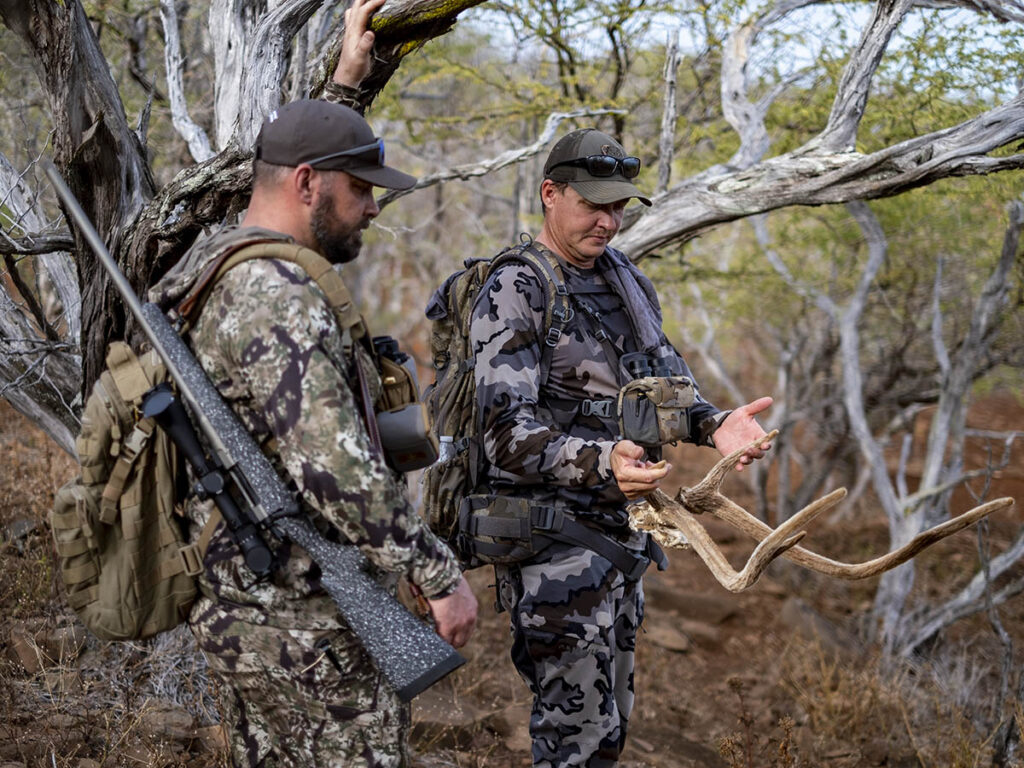
To be honest, that feeling was troublesome at first. There was little effort made to conceal the fact that this blind was used often, and per my experience, when deer are shot at from a specific location, they have a way of locking that into their long-term memory. However, experience has also taught me to trust someone like Ku, who lives around these deer and hunts them enough to make me permanently jealous.
That first herd of eight — the irony caused a little internal chuckle — walked past us 168 yards out, in single-file fashion, on the way back to bed from their nocturnal feeding fields some two miles away. Some were bucks and some were does, but the lack of light escorted them safely back to their bedroom over a nearby ridge.
“Here comes some more,” whispered Ku. It turns out he misspoke.
Less the five minutes after the first herd had passed, what I would call a “sh*tload” of deer began their march past us, exactly within the tracks of their predecessors. Fawns. Does. Bucks. Bleating. Barking. Marching. If there were 50, there were 200. One right after another, from left to right.
Oddly enough, the challenge was picking one on which to paint the crosshairs. About the time I’d spot a buck that was a bit bigger than the rest, another would materialize. And by the time I assessed that buck, the first one was already out of sight.
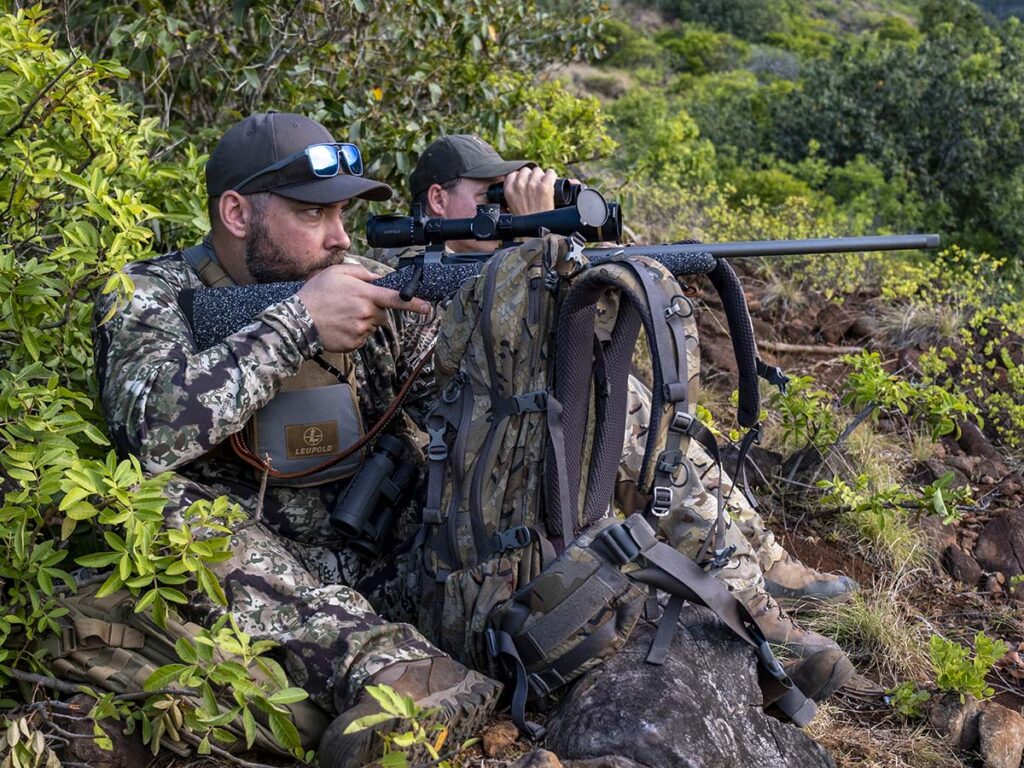
“There’s a good one, exactly in line with that lone tree. See it? Can you stop them, Ku?”
At a range of about 175 yards, with a 6.5 Creedmoor and a 100-yard zero, the holdover is close enough to nothing that it’s not worth thinking about, but when you’ve got a riflescope that allows you to dial dead-nuts in less than a second, I’ll take that second. And hitting a walking target at that distance isn’t a particularly challenging shot, but I’ll also take a stationary target any time I can get one. I tracked the walking buck with the crosshairs on the leading edge of his shoulder, waiting for the brief-but-sufficient pause that would come when Ku worked his magic. This almost always works on whitetails, so it should work on axis deer, too, right?
At the sound of the whistle, the entire herd made tracks and disappeared so quickly it seemed to defy physics. I was dumbfounded, as was Ku. There was nothing for either of us to do but look at one another in disbelief as the smell of their dust drifted through the blind.
Worrying that the morning migration was over, and assuming that half the island heard the stampede, I had to wait an entire 20 minutes before more deer began working our direction. After all, the island does boast a population density of nearly 2½ deer per acre.
Looking back on that moment, I think I felt a little bad for the lead doe, because she led a string of 11 bucks that clearly had no intention of leaving her. Oddly enough, the bucks progressed in ascending age, with a yearling spike nipping at her heels.
At the end of the line was a decent buck: I had passed numerous deer bigger than he, and I still had two days remaining in the hunt to find a bigger deer (and to fill all three of my doe tags), but I instantly knew this was the buck I wanted. His antlers were little more than average, but he was gray in the face with darker neck hairs that gave way to a beautiful red-and-white-spotted body.
After four days of hunting, “the moment” was a bit anticlimactic. The buck turned, I shot (behind the shoulder, as to not waste a drop of that precious axis meat), and he toppled within seconds before coming to rest in the red Hawaiian dirt.
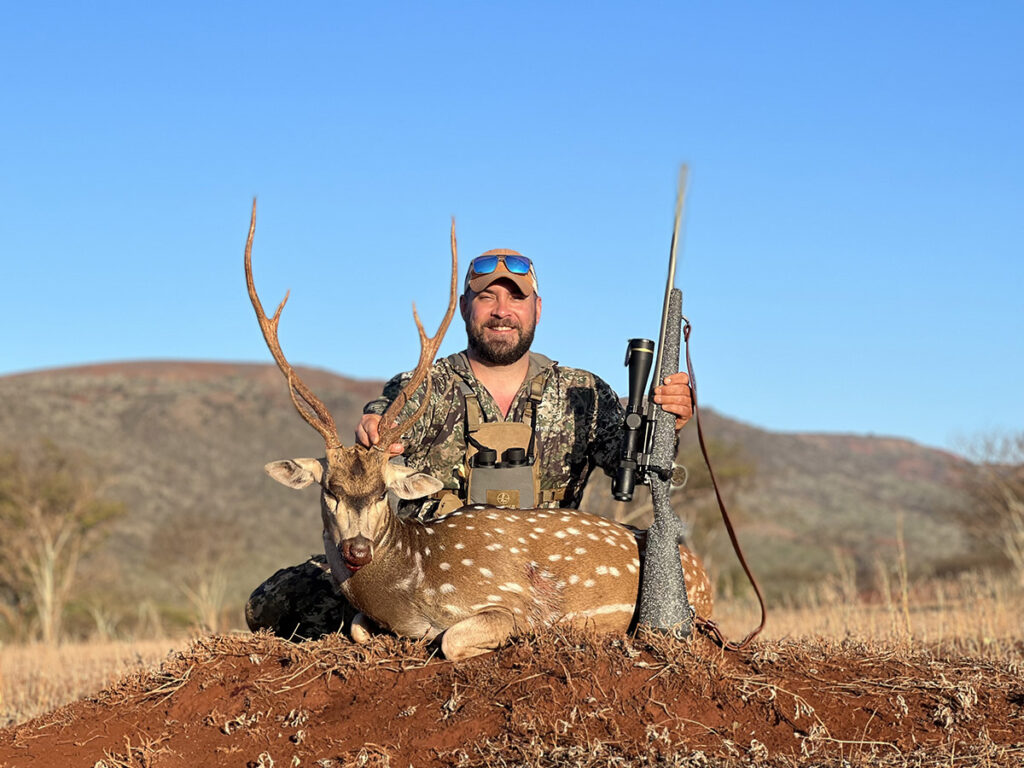
Ku and I hugged because, well, I’m a hugger and it seemed like the right thing to do in celebration of a moment that will forever live between my ears as an exceptionally fond memory.
And, best of all, it’s a moment I will re-share with my family months from now, deep in the grasp of yet another Minnesota winter, with a fire warming our home and table full of Hawaiian axis deer gracing our table.
Field Notes: Nosler Model 21
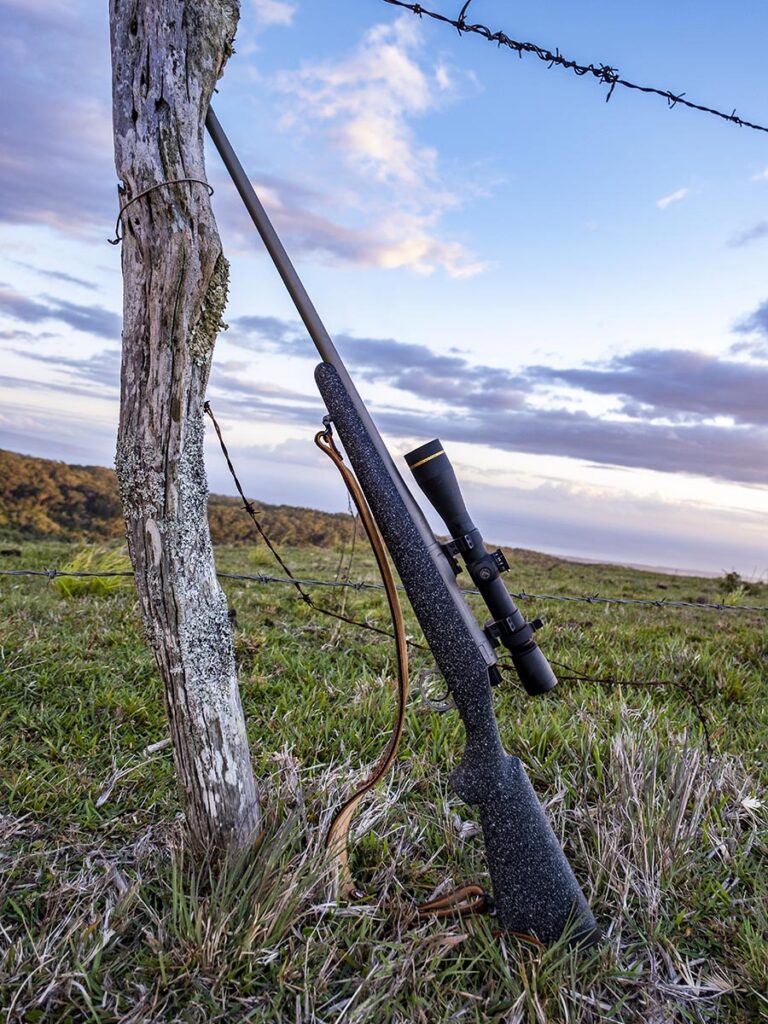
“Out with the old and in with the new” is so often the mantra of manufacturers across the board simply because consumers like new guns. There aren’t many people out there who want to buy a brand-new truck in 2022 that came out in 2018 … even if it has zero miles on it.
Same holds true for rifles — and just about everything else money can buy.
But every once in a while, a rifle comes around that’s just a bit different than everything else on the market. That’s an accurate description of Nosler’s Model 21. You’ll see it in nearly every photo of my Hawaiian axis deer hunt because that hunt, by design, was a test that begged for my honest assessment of what the rifle has to offer.
Built on the new Model 21 action, Nosler worked with the Mack Brothers of South Dakota — who made one hell of an introduction into the precision rifle shooting world in 2018 with the EVO action — to build a rifle around an action that floats like a butterfly yet stings like a bee. Nosler then took that action, bedded it in a carbon-fiber McMillian stock, added a Shilen match-grade stainless steel barrel, fluted the bolt, and bolted on a TriggerTech trigger.
Those are all the tangibles, but equally important is the intangible fact that the rifle simple feels right in-hand and while shouldered. It just fits. The balance is exceptional, and the precision this rifle is capable of is impressive. Depending on each rifle’s specific chambering, the Model 21 weighs within a couple ounces of 7 pounds — the sweet spot I prefer in a hunting rifle that isn’t too heavy yet still weighs enough to not thump like an NFR bronc.
And, the rifle is damned sexy … which is almost as important as how it shoots.
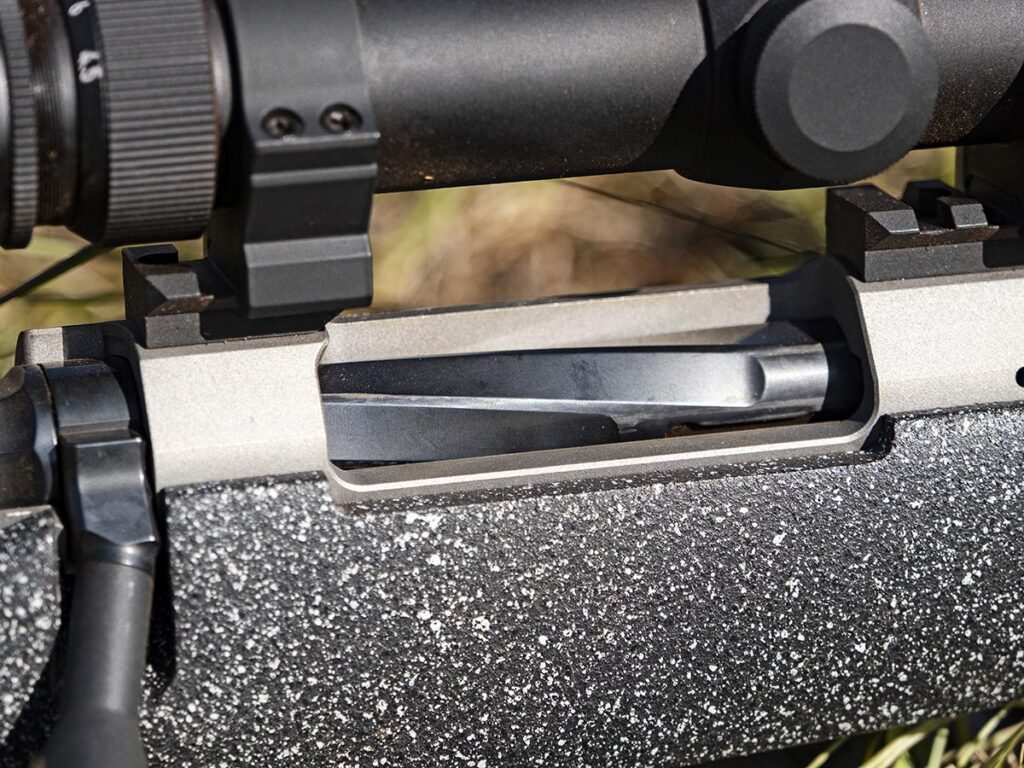
At present, Nosler is offering the Model 21 in 22 Nosler, 6.5 Creed, 6.5 PRC, 26 Nosler, 27 Nosler, 280 AI, 28 Nosler, 308 Win., 300 Win. Mag., 30 Nosler, 33 Nosler, and 375 H&H Mag. If you can’t find a chambering in this list that gets you excited (especially that 280 AI), then there’s nothing I can do for you.
Here’s the bottom line: Nosler isn’t giving this gun away, but that doesn’t mean the gun isn’t an excellent value.
Having a billet-machined receiver with tolerances within 0.001 inch, mated to a barrel that was machined to match-grade specs and individually bedded into a custom carbon-fiber stock, is like building your own custom rifle. A rifle that can cost anywhere from $5,000 to $13,000 by other manufacturers’ standards, you can get for about $2,800. And while it’s not a $700 rifle, you’ll also know that every single part on this rifle is built to not only last your lifetime, but also your grandkids’ as well.
It’s like driving a full-sized truck that features the handling of a sports car and the fuel efficiency of a tiny two-door sedan: You get everything you could want, all in one package … without sacrificing anything.
Field Notes: Aloha Gear

Good glass is always as important as the quality of a rifle, regardless of where in the world the hunt takes place. Leupold’s Custom Dial System (CDS) allows the shooter to range, dial, hold dead-on, and shoot. Provide Leupold with your rifle’s specifics, and they’ll provide you with a game-changing dial.
Due to the warm climate, axis deer are very thin skinned, and the Ballistic Tip bullets were causing a significant amount of meat loss on the bullet’s entry — though 24 deer were shot in our group and all were recovered. Nosler also makes a 140-grain AccuBond, which cause more localized tissue damage upon entry, but it’ll likely penetrate through both shoulders, causing localized tissue damage upon exit as well. Pick your poison.
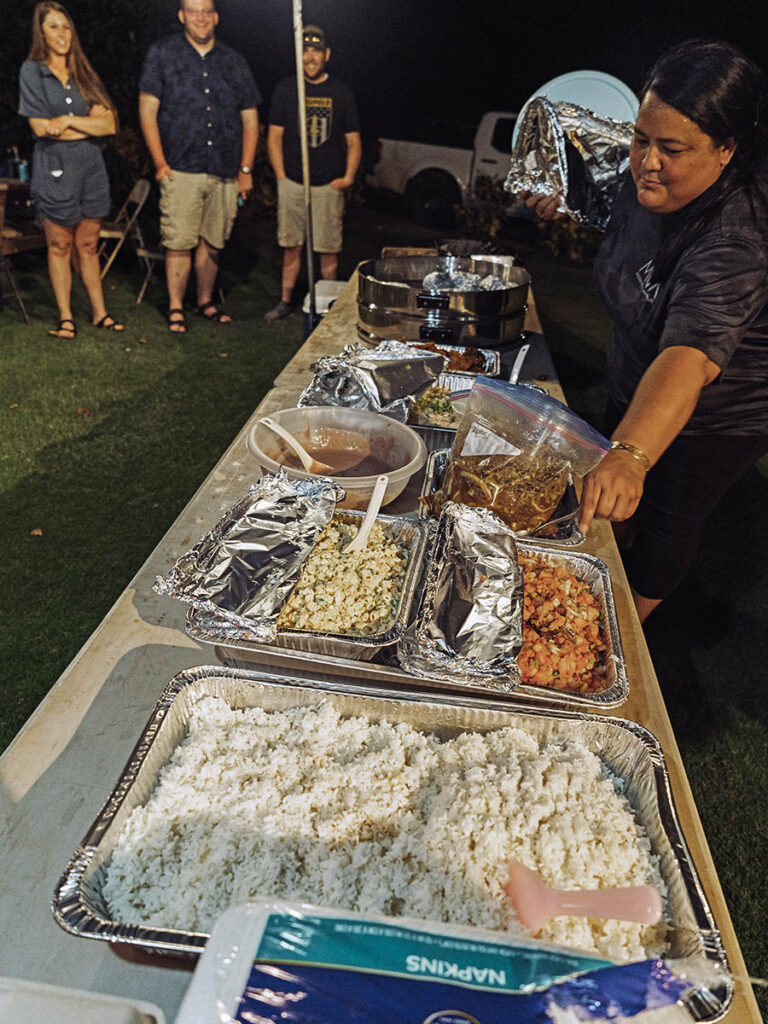
For game preparation, Camp Chef offers nearly anything you could want, from heat sources such as pellet grills and griddles — to knives, cast-iron, and everything in between.
Hunt. Kill. Butcher. Cook. Consume. Repeat.
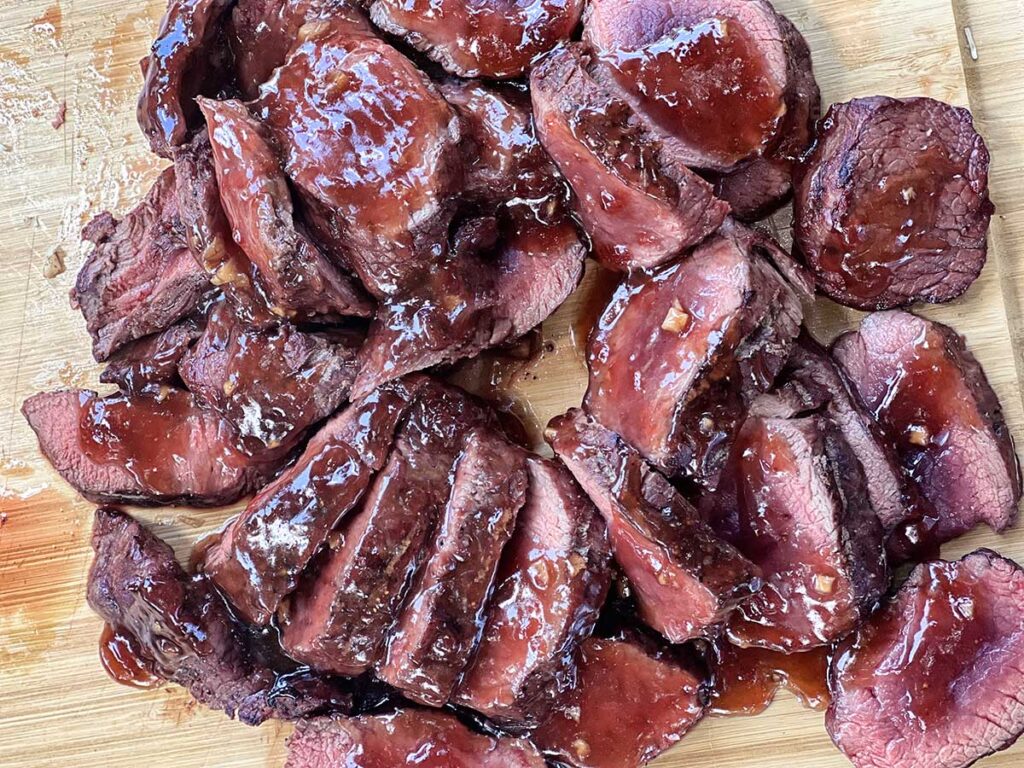
Field Notes: If When You Go
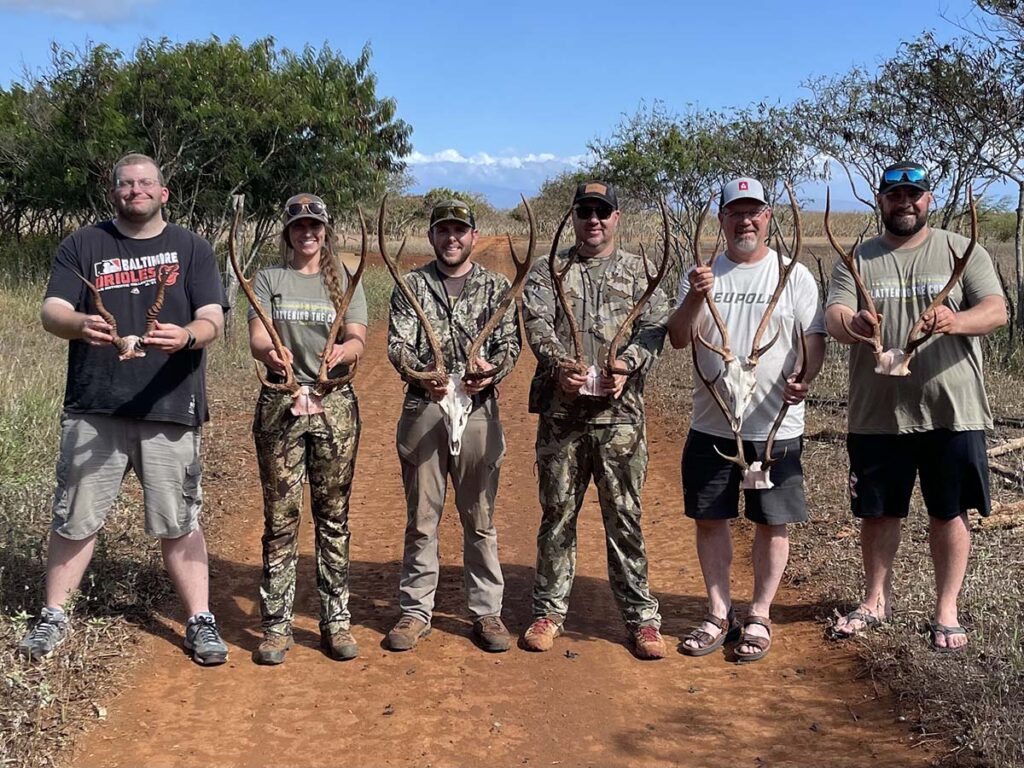
For those who’ve had it, axis venison rivals elk for the title of the best wild game meat. Yes, it’s indeed deer meat, but it tastes nothing like whitetail.
If that’s not enough to get you checking flights to Honolulu, consider the fact that an axis deer hunt is an exceptional addition to any family vacation. Hunt in the morning and spend the remainder of the day at the beach with your crew. Maui offers the best combination of beaches and axis hunting opportunities on a single island, though I fell in love with the rugged simplicity of Molokai. When I go again with the family, I’ll likely stay on Maui and catch a quick-and-cheap flight over to Molokai for a couple days to hunt.

While traversing the mountainous terrain of the Hawaiian Islands can be challenging — this is every bit a hunt — I’ve got no hesitation in saying that you’ll get your deer if you meet up with the right people. And if you’ve never done it, flying with a rifle will take less effort than making sure your significant other keeps the weight of her suitcase below 50 pounds.
Our group hunted with Go Hawaii Outfitters, who handles the bookings. Once you arrive, you’ll hunt with Ku Keanini of Ku’s Outdoor Adventures (just prepare yourself: Ku is also a hugger). It’s intoxicating how intimately Hawaiians build their lives around family, and that’s exactly how we were treated during the entirety of our stay.
Go Hawaii Outfitters: HuntingOutfittersHawaii.com // gohawaiioutfitters@gmail.com
Editor’s Note: This article originally appeared in Carnivore Magazine Issue 8.


